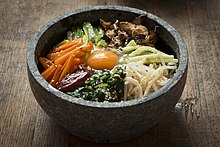 Dolsot-bibimbap (hot stone pot bibimbap) | |
| Type | Bap |
|---|---|
| Place of origin | Korea |
| Region or state | East Asia |
| Associated cuisine | Korean cuisine |
| Variations | Dolsot-bibimbap, Jeonju-bibimbap, Jinju-bibimbap, Tongyeong-bibimbap |
| Korean name | |
| Hangul | 비빔밥 |
|---|---|
| Revised Romanization | bibimbap |
| McCune–Reischauer | pibimpap |
| IPA | [pi.bim.p͈ap̚] |
Bibimbap[1] (/ˈbiːbɪmbæp/ BEE-bim-bap;[2] Korean: 비빔밥; lit. "mixed rice"), sometimes romanized as bi bim bap or bi bim bop, is a Korean rice dish.
The term bibim means "mixing" and bap is cooked rice. It is served as a bowl of warm white rice topped with namul (sautéed or blanched seasoned vegetables) and gochujang (chili pepper paste). Egg and sliced meat (usually beef) are common additions, stirred together thoroughly just before eating.[3]
In South Korea, Jeonju, Jinju, and Tongyeong are especially famous for their versions of bibimbap.[4] In 2017, the dish was listed at number 40 on the World's 50 most delicious foods readers' poll compiled by CNN Travel.[5]

- ^ 주요 한식명(200개) 로마자 표기 및 번역(영, 중, 일) 표준안 [Standardized Romanizations and Translations (English, Chinese, and Japanese) of (200) Major Korean Dishes] (PDF) (in Korean). National Institute of Korean Language. 30 July 2014. Archived (PDF) from the original on 23 January 2019. Retrieved 15 February 2017.
- 주요 한식명 로마자 표기 및 표준 번역 확정안 공지. National Institute of Korean Language (Press release) (in Korean). 2 May 2014. Archived from the original on 11 June 2023. Retrieved 15 February 2017.
- ^ "bibimbap". OxfordDictionaries.com. Archived from the original on 25 September 2016. Retrieved 8 January 2017.
- ^ "Organic Vegetables Bibimbap". Seoul Metropolitan Government. Archived from the original on 1 October 2011.
- ^ Chung, Kyung Rhan; Yang, Hye-Jeong; Jang, Dai-Ja; Kwon, Dae Young (2015). "Historical and biological aspects of bibimbap, a Korean ethnic food". Journal of Ethnic Foods. 2 (2): 74–83. doi:10.1016/j.jef.2015.05.002.
- ^ Cheung, Tim (12 July 2017). "Your pick: World's 50 best foods". CNN. Archived from the original on 11 November 2012. Retrieved 14 August 2021.